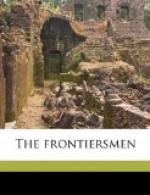NOTES
1. Page 6. The annals of the southwestern settlements commemorate many instances of daring hearts in delicate frames, and the pioneer woman who perhaps under softer and safer circumstances would have screamed at a mouse often shouldered a rifle and bravely joined the frontiersmen in the defense of the stockade against the most cruel, most wily, most warlike savage foe that ever a civilized force encountered. Courage, of all the qualities of the moral panoply, is the least to be reckoned with by logic. Perhaps after all it is not inherent, even in the nobler organisms, but evolved by a conscientious sense of responsibility and the dynamic potencies of emergency. La Bruyere says: “Jetez-moi dans les troupes comme un simple soldat, je suis Thersite: mettezmoi a la tete d’une armee don’t j’aie a repondre a toute l’Europe, je suis Achille!”
2. Page 114. The chungke stone of this favorite game of the southern Indians bears a certain resemblance to the ancient discus of the Greek athlete. This, it will be remembered, fashioned of metal or stone, circular, almost flat, was clasped by the fingers of one hand and held in the bend of the forearm, extending almost to the elbow. The genuine chungke stone is solid and discoidal in shape, beautifully polished, wrought of quartz, or agate, the most distinctive being concave on both sides, beveled toward the flat outer edge, and having a depression in the centre of both surfaces for the convenience of holding it with the second finger and thumb, the first finger clasping the periphery. Its usual dimensions are about six or eight inches in diameter. There are several varieties of these archaic relics, some flat, others lenticular or of a wedge-shell shape, and others, still, concave on one side and convex on the other. An absolutely spherical stone, bearing the extraordinarily high polish that distinguishes these unique objects, found in an ancient mound and supposed to have relation to the same or a similar game, calls to mind the globular quoit of the classical athletes and that “enormous round” described by Homer, “Aetion’s quoit”—to hurl which bowl they vie, “who teach the disk to sound along the sky.”
The exquisite finish of the chungke stone was compassed without the aid of a single tool, merely by the attrition of one stone upon another, “from time immemorial rubbed smooth upon the rocks, with prodigious labor,” resulting in an object of such symmetrical beauty that even in the museums of the present day, out of which it is rarely seen, it challenges admiration. Antiquaries variously contend that it was hurled through the air and that it was bowled on the edge along the ground, its equilibrium being so perfect that on a level space it will roll a great distance, falling only when its impetus is expended.
The chungke stone is often confounded with the Indian quoit, likewise circular and fashioned of smoothly wrought stone, but with an orifice in the centre, rendering it in effect a ring to be flung over a stake at a distance, or to be caught on the point of a lance.




